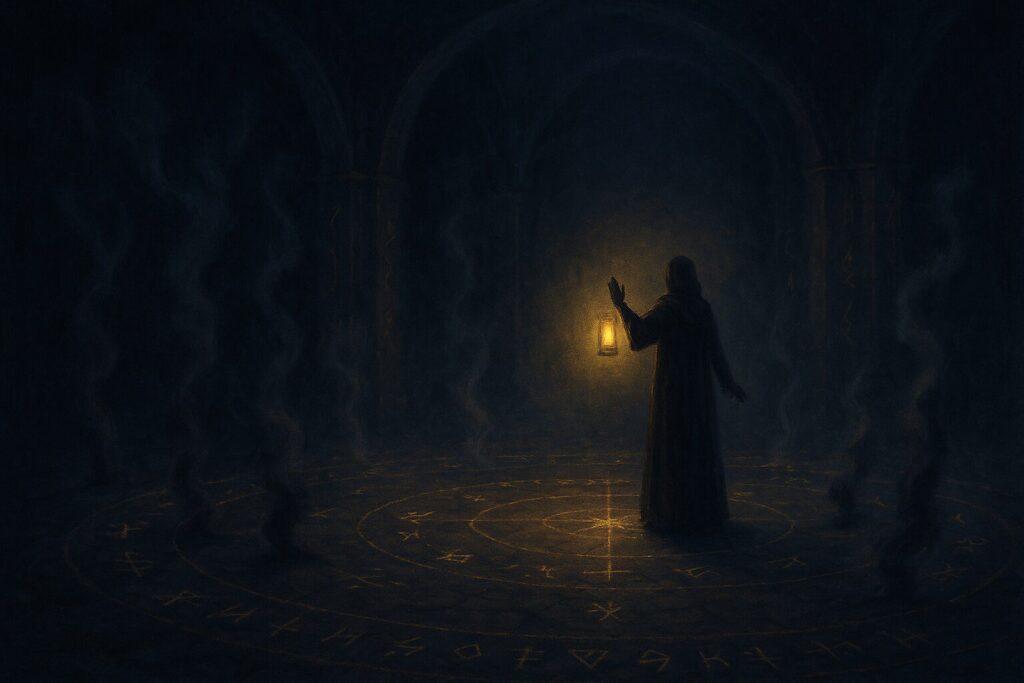Demonology

In witchcraft, the word demon does not carry the terror it does in religion or popular media. A witch does not cower before the unseen; they observe, discern, and engage with it as one who knows the landscape of spirit. Fear amplifies the very forces it seeks to repel, and thus witches are taught to meet darkness with composure. The unseen world, like the natural one, contains predators, parasites, and storms—but also balance, order, and renewal. Demons, in the witch’s lexicon, are not a race of devils but manifestations of imbalance, energy gone awry, or fragments of consciousness severed from harmony.
The roots of demonology lie not in malice but in misunderstanding. In the ancient world, the Greek daimon referred to a spirit or intermediary intelligence—neither good nor evil, but a being of insight and influence. The transformation of the daimon into the demon was the work of monotheism, which sought to collapse the complex pantheon of spirits and minor deities into a single moral binary. Pagan gods and tutelary spirits were recast as rebels against one god’s order; what had been numinous became profane. Wicca and modern witchcraft deconstruct this inheritance, returning the spirit world to plurality and nuance. The universe, after all, is not divided by moral law but bound by energetic correspondence.
Psychology and parapsychology offer further insight. In Jungian terms, what is called a demon often corresponds to the shadow self—aspects of the self repressed, feared, or denied until they appear projected outward. Energetically, this projection becomes form. In the language of magic, emotion and focus feed thoughtforms; what we resist, we charge. Parapsychology reframes such phenomena as psychic residues or “egregores”—fields of emotion taking on temporary life. A witch understands these not as evil in themselves but as psychic feedback loops: fear giving birth to more fear. Thus the work is not always exorcism, but integration—transmuting the energy through understanding and will.
Yet not all dark presences are purely internal. There are entities that cling and feed, parasitic in temperament. These are not ancient demons of theology but energetic scavengers, drawn to confusion, grief, and volatility. Many ghost hunters and modern “demonologists” encounter such energies and amplify them through dramatization, fear, and spectacle, mistaking echo for malice. Witches recognize the same principle as in nature: stagnant pools breed decay. Where energy is neglected or emotion runs unchecked, parasitic forms gather. They are dispatched not with holy water (unless properly enchanted), but with steadiness, light, and clarity of will. Fear empowers the feared; calm dissolves it.
Dark gods, too, exist within MCC’s worldview, but they are not to be conflated with these entities. They are archetypal teachers—challenging, demanding, and transformative. To meet them is to confront the deeper patterns of power, death, and rebirth. The witch does not shun them, but approaches with discipline and purpose. Demons, by contrast, are often fragments—lesser intelligences or reflections of human distress. Both reveal truth: the gods by choice, the demons by distortion. In this sense, every haunting is a lesson in resonance—what within us called and what within us must be rebalanced.
Demonology, for the modern witch, is not a catalog of evil but a study of energy, psychology, and responsibility. It asks: what have we created through fear, and how do we reclaim it? The witch neither denies the dark nor romanticizes it; they work with it as they would any storm. Summoning is rarely necessary, for the dark will find the unguarded. The better art lies in boundary and mastery—banishing through brightness, cleansing through intention, and meeting all currents with the sovereignty of one who knows their own flame.
To understand demons is to understand the nature of projection itself. Most are mirrors, showing us the forms our emotions take when untended. Others are opportunists, feeding on the shadow we forget to own. Either way, the antidote is the same: awareness, equilibrium, and calm authority. Witchcraft teaches that darkness, when faced without fear, loses its power to deceive. What is named is known; what is known can be transformed.

